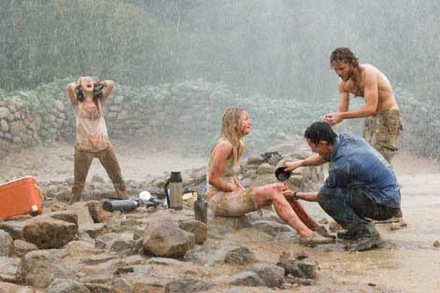
In general, the quality of something is a result of the company that surrounds it. For example: you are presented the opportunity to choose between a BMW, a Ford Focus, and a Saturn Ion. Clearly, the BMW takes the prize. In contrast, if you are presented with a Saturn, a Yugo, and a Datsun, the Saturn would finish on top eight out of ten times. (One must adjust for the possibility that Yugoslavians are among the choosers) This is what I like to refer to as the Danica Patrick paradox: in a room with Giselle Bundchen and Anna Kournikova, Patrick would probably be the last one chosen. On the other hand, surround her with forty men or the LPGA, and she’s your Venus. The same theory can be applied to movies.
Recently, HBO has been running The Ruins quite regularly, and for some reason, I can’t not watch it. In the morning over my cup of coffee, it’s on, and I have to watch it. When I finish work and settle in for the evening, I must watch it. (Programming note for HBO: you might want to reconsider your choice to show The Ruins at 8am. Even though I’ve been warped since age five on account of having a Wiccan babysitter who insisted that I hold the gold chalice to harvest the blood while it’s warm, you wouldn’t want some six year old searching for HBO Family to stumble upon an Austrian tourist having his legs amputated with a jagged rock)
Either way, at first, I chalked my budding addiction up to Laura Ramsey, who prances across the screen in a white tank top, but eventually that wore off, and I was left to ponder how my taste in movies was being satiated by what appears to be a low-budget movie whose premise (a group of tourists wander through a foreign country) is reminiscent of the Hostel franchise.
While I have nothing against Eli Roth—he’s quite solid as the bat-wielding Bear Jew in Inglourious Basterds, and I appreciate that he can gross two hundred times the amount of money that he puts in to some truly gruesome films—the Hostel franchise doesn’t interest me as it tends to be primarily a vehicle for snuffy indulgence.
Since The Ruins is not void of cringe-worthy scenes—particular when the abovementioned Laura Ramsey filets herself to extract the parasite that has intruded her body through an open wound in her knee—my confusion grew. Though, what I began to notice, or forced myself to notice, is that The Ruins does not follow the same formula as a number of horror films in which a group of teenagers stumble upon a dilapidated house that augurs the existence of evil wraiths and specters but who decide to throw caution to the wind and decry the nearly desiccated, scarred elder who exposited the dangers of said house and offered a warning only five minutes prior. Instead, the characters in The Ruins are enjoying their last few days of a vacation in Mexico when they decide to visit an archaeological dig with Hans, another hotel member, whose brother and wife are excavating the ruins.
Likewise, the formulaic trope is further broken when our group of tourists locate the ruins and are not drawn in by the need to put on a brave façade, but rather the aesthetics of the orange-flowered vines. While the group is enraptured and snapping photos, men on horseback emerge and point revolvers and arrows at our tourists, disallow them to leave, forcing them to seek refuge at the summit of the ruins.

Eventually, we learn that the beatific vines are carnivorous parasites that slowly work their way into the human body, transforming it into a surrogate to allow germination outside the perimeter of the ruins, so the tourists must be contained until they die. From this point on, the movie progresses like a number of horror films in that the majority of the characters die rather horribly; a primary difference is that these deaths are paranoia-driven and result in euthanasia and self-sacrifice rather than by a botanical boogeyman.
At the same time, because the discovery of the ruins stems from innocent curiosity, and not narcissism or the goal of impressing a bubbly young girl, sympathy is fostered for the characters. Admittedly, if you’re watching The Ruins, you’d expect most everyone to perish, though for some reason I was a bit more disturbed when these characters bit the dust as opposed to anyone who says “I wonder what’s in the room of hanging meet” in the 2003 version of The Texas Chainsaw Massacre or Paris Hilton in the reboot of House of Wax—though that might just be a natural reaction to seeing Paris Hilton penetrated by a pole (hmmm…seems quite appropriate that her career was launched the same way in which she dies on film).
A final element that differentiates The Ruins is the acting. It’s, well, thin, but not awful, which means that it’s pretty good for a horror movie. And while the story dabbles in seriousness inasmuch as it substitutes the common sex + drugs = death trope with intruding upon that which is unfamiliar for the sake of a digital memory = death notion, it doesn’t take itself too seriously.



